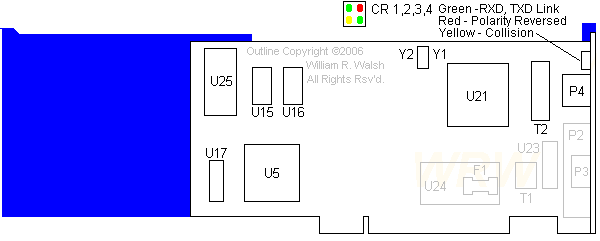
Cabletron MCA Network Interface Cards (10baseT, 10base2, Fiber)
Has anyone ever seen the fiber version of the E30xx cards? Tell me!
Cabletron E3100

Y1, 2 - Seiko Epson 20.0000MHz
T2 - Toko PM05-30
U5 - Altera EPB2001LC
U15, 16 Samsung KM6264BL6-7
U17 - Ethernet (MAC) Address
U21 - National DP83902V
U25 - Boot ROM
Parts in grey are not populated on this adapter. Most are for a coaxial version of this card.
U23 - IC
U24 - DC-DC Converter Board
F1 - Fuse
T1- Transformer
P3 - Coaxial (10base2) Plug pads
P2 - Solderpads and outline for AUI connector
Cabletron E3020

Components:
U1, 2 - Fujitsu 8464A-80L RAM
U3, 4, 6 - PALs
U5 - GAL
U7 - SMC 94C18 MCA bus interface
U8 - National Semiconductor DP8390 Ethernet Controller
U9 - National Semiconductor DP8391 Serial Network Interface
U10 - National Semiconductor 74ALS04
U23 - Linear Technology LT1172CT regulator
X1 - Seiko Epson 20.0000MHz
T1 - Nano Pulse 5421-00
T2 - Burr Brown "Power Convertibles"
T2 - Round Valor transformer
Yes, I know there are two "T2" entries on the outline above. Maybe
I will even fix it. Blame the folks who can't label a PCB with
component IDs. All component IDs are made up except for U7 and U23.
Both of those items are shown with their correct component IDs.
Total Hardware '99 disagrees regarding the red and yellow LEDs. Red is claimed to indicate collisions, yellow the transmission of data. I think I've got it right, but who knows this many years later?
Fuse
The function of F1 (fuse) appears to be protection against too much current draw through the AUI port. It is socketed, so you can replace it with another 2AG fuse. Just be sure you've solved the overload problem first, otherwise you may risk damage to the board traces from prolonged or repeated overcurrent conditions. (The linked PC Magazine article says the fuse is for "for extra protection of transient voltages that might, through accident or miswiring, be imposed on the LAN wiring".)
Cabletron E3010

Sorry folks, nearly all the component IDs are made up. I'd guess the actual IDs are hidden under the components, and I'm not about to unsolder them. This is more or less a TP cable version of the E3020.
U1, 2 - Hyundai HY6264LP-10
U3 - 2150121
U4 - 16L8 PAL
U5 - 16V8A GAL
U6 - AMD PAL (20L108PC)
U7 - SMSC 94C18 (MCA bus interface, dated 1/90)
U8 - National Semiconductor DP8390CN
U9 - Cabletron L1A4268 (customized T7220PC?)
U10 - Universal Microelectronic Company AD08AA050 Tapped Delay Line
X1 - 20.00000MHz
T1 - Valor LT1750
CR1-4 - Link/TXD-RXD/UTP Polarity Reversed/Collision
F1 - Fuse 250V 1A
SW101 - Signal Quality Error (SQE) Test
SW1 - AUI/TP Select (up for AUI, down for Twisted Pair)
Enterasys says the following about the SQE Test setting:
The Signal Quality Error (SQE) Test Switch allow you to enable or
disable the SQE ("hearbeat") internal test function on the DNI Card.
You generally disable the SQE, unless you are checking the validity of
the SQE Test. The SQE Test signal does not leave the card. If the DNI
Card is attached to the network through the AUI port, the SQE should be
set in the external transceiver. The SQE is disabled when the card is
shipped.
Total Hardware '99 disagrees regarding the red and yellow LEDs. Red is claimed to indicate collisions, yellow the transmission of data. I think I've got it right, but who knows this many years later?
Fuse
The function of F1 (fuse) appears to be protection against too much
current draw through the AUI port. It is socketed, so you can replace
it with another 2AG fuse. Just be sure you've solved the overload
problem first, otherwise you may risk damage to the board traces from
prolonged or repeated overcurrent conditions. (The linked PC Magazine
article says the fuse is for "for extra protection of transient
voltages that might, through accident or miswiring, be imposed on the
LAN wiring".)
Experiences
I've used this card in a Model 53SLC2 for some time with good results. The built in Windows 95 drivers run the card well and are reliable.
Windows
All of the Cabletron Ethernet adapters I have (E3010, E3020, E3100)
perform well under Windows 95 and 98 with the available or included
drivers. Windows NT doesn't appear to be supported (unless there are
built in drivers, which there are not for the E3100 models) beyond
version 3.5. Loading the NT 3.5 drivers results in the message "a
device attached to the system is not functioning" in the event log.
(This could be a by-product of the slot counting bug, first fixed in
Service Pack 3 for NT4.)
The E3100 board appears to be a "shared RAM" type...
Cabletron Files
Look here. (Probably all you will find, since the darkness fell.)